The complete guide to the best hearing protection devices for shooting in 2023. Plus, some tips on how to choose them!
| Name | NRR | Attack Time | Directional Sound | Price |
|---|---|---|---|---|
| Peltor Sport Tactical 500 Best Overall | 26dB | 3-5ms | Y | BUY |
| Howard Leight Impact Sport Bolt Strong Runner-Up | 22dB | 0.5ms | Y | BUY |
| Act Fire Shooting Earmuffs Best Budget | 23dB | 20ms | Y | BUY |
| OTTO Engineering NoizeBarrier Micro Best Premium | 40dB | 20ms | N | BUY |
| Walkers Silencer BT 2.0 Best In-Ear | 24dB | 20ms | N | BUY |
| GLORYFIRE Electronic Shooting Earmuff Best for Hunting | 25dB | 20ms | Y | BUY |
| PROHEAR 030 Most Versatile | 22dB | 10ms | N | BUY |
| Walker's Game Ear Razor Slim Most Comfortable | 23dB | 20ms | N | BUY |
| PROHEAR 016 Best Passive Ear Muffs | 26dB | N | N | BUY |
| SureFire EP10 Sonic Defenders Best Passive Earplugs | 30dB | N | N | BUY |
How to Pick the Best Hearing Protection for Shooting
Gunshots can reach up to 140-190 dB, which is 20-60 dB louder than the noise exposure limit. So, to avoid irreversible hearing loss, hearing protection devices are essential.
However, you can’t just go with any hearing protection device. Most regular hearing protection devices aren’t suitable for shooting; they don’t offer enough protection and can interfere with other safety equipment.
That’s why knowing which features you should prioritize can make choosing a HPD for shooting much easier. Read on to find out everything you need to know, as well as see our top ten picks for 2023.
Why do you need hearing protection when shooting?
Gunshots can be painful and even permanently damaging to your ears if you don’t wear hearing protection.
According to the CDC, exposure to noise greater than 120dB can permanently damage your hearing.
Unfortunately, as previously mentioned, unsuppressed gunshots reach 140-190dB– easily within the dangerous range. This means that hearing protection is necessary when shooting if you want to keep yourself safe.
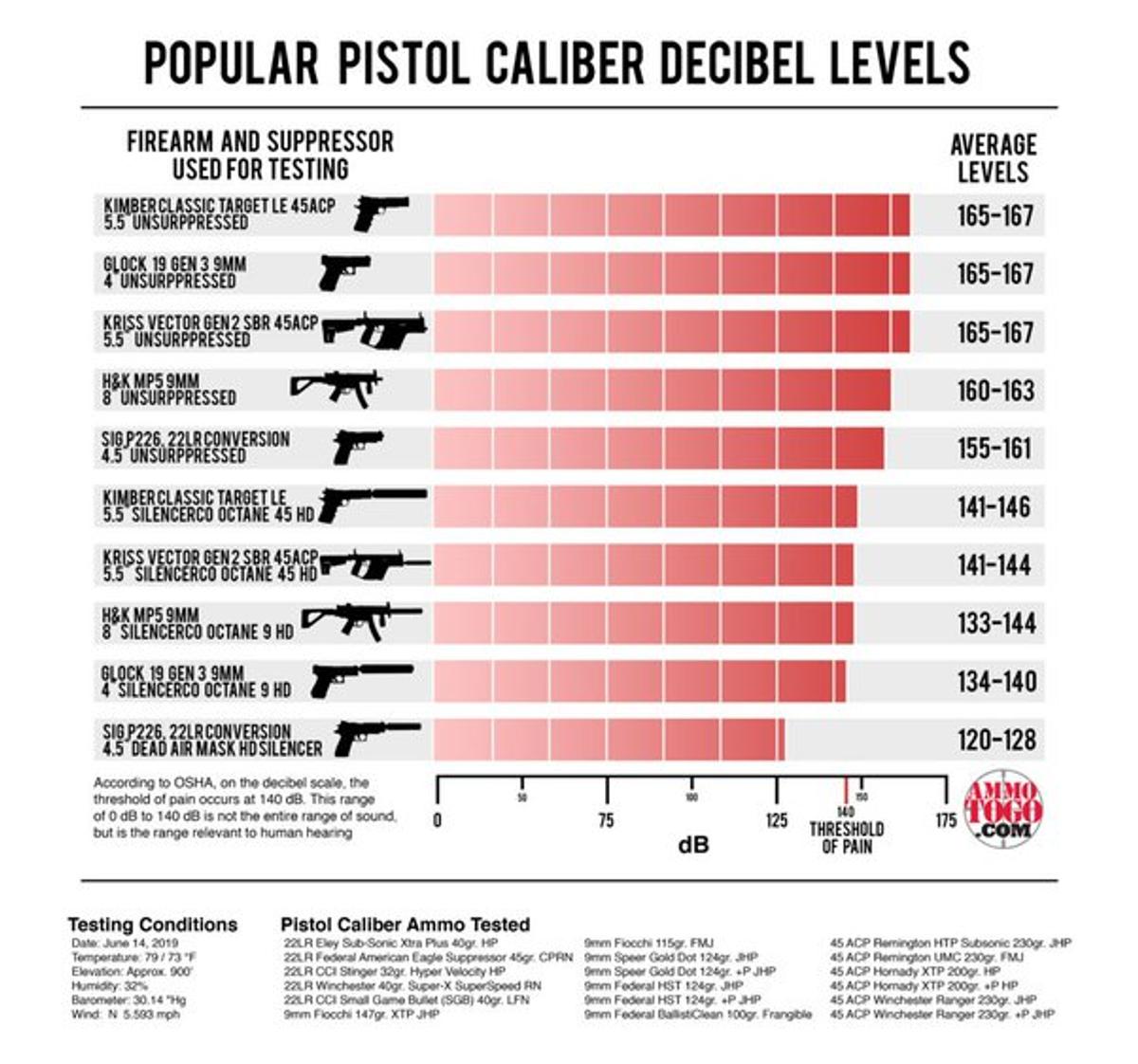
How do gunshots cause hearing damage?
Inside your ear are thousands of tiny hair cells that allow your brain to detect sounds. The percussive waves of loud noises, such as gunshots, can overwork these cells, causing them to die.
Loud noises can cause damage to the auditory nerve, which can heighten your risk of developing hearing problems later in life.
This damage results in muffled sounds and/or ringing in your ears. These effects will often fade after a few hours or days as your ears recover. However, repeated exposure to loud noises will kill enough cells that the damage becomes permanent.
How much hearing protection do you need when shooting?
The minimum amount of hearing protection you’ll need depends on two factors: the volume of the gun you’re using and how long you’ll be exposed to the dangerous levels of sound.
When it comes to the volume of the gun, you’ll need hearing protection capable of reducing the sound to under 120 dB. For example, if your gun fires at 143 dB, you’ll need at least 23 dB of hearing protection to be safe.
The length of time you’ll be shooting also affects the amount of hearing protection you’ll need, especially at a shooting range where you’re constantly exposed to sound.
The longer you’re exposed to high sound levels, the more at risk you are.
For example, 100 dB of sound won’t cause instant damage, but you can be at risk if you’re exposed for more than 15 minutes. If you plan to shoot for more than a few hours, aim for noise reduction that will reduce your exposure to below 85 dB– the OSHA standard.
You can use the NRR rating of a hearing protection device for these calculations. The Noise Reduction Rating (NRR) roughly estimates the maximum decibels a particular hearing protection device (HPD) can protect against. This means a set of earplugs with an NRR of 33 will reduce up to 33 dB of noise.
However, the NRR isn’t always accurate in application. The testing done to get this score is done in a controlled facility, so there’s a gap between the NRR and its real-world functionality.
To get an accurate measurement, you’ll need to ‘derate’ the NRR– a process you can learn more about in our article explaining NRRs.
Ear muffs vs. earplugs for shooting: Which should you go for?
Earplugs are cheaper and more convenient, but often have a lower derated NRR than earmuffs of similar quality. Additionally, they’re more prone to misuse and improper sizing, as you’ll need different sizes and fits of earplugs depending on the size and shape of your ears. The wrong fit can lead to poorer results.
Earmuffs, on the other hand, are bulkier and can sometimes interfere with other safety equipment, such as safety glasses. Additionally, they’re often more expensive than earplugs.
However, they offer a one-size-fits-all approach, which means that any pair of earmuffs will more likely fit you.
Ultimately, choosing which form to go for depends on your preferences.
But, you don’t actually have to choose between one or the other. Ideally, using both earmuffs and earplugs at the same time is recommended. This provides an optimal hearing protection and increases the reduction for up to 5 dB.
Passive vs. electronic hearing protection
Another factor to consider is whether you should go for passive or electronic hearing protection:
- Passive hearing protection: This refers to earmuffs not enhanced by technology but instead rely on the thickness of the ear pads to muffle all incoming noise. With this, the earmuffs will also block range commands and other important noises around you.
- Electronic hearing protection: Electronic HPDs come with integrated speakers that enhance the surrounding environment’s audio. The enhancement will turn off when it detects dangerous levels of sound such as gunshots. Some electronic HPDs will also include a headphone jack or Bluetooth connection, so you can listen to music or podcasts while shooting.
Though more expensive, HPDs with electronic protection are generally preferred. They always come with sound amplification, which helps you stay aware of your surroundings and hold a conversation without risking your hearing.
Additionally, some electronic hearing protection devices come with the extra upgrade of directional sound amplification. This feature uses a multi-speaker system so you know where the sound comes from, such as your comrades’ voices or the prey’s footsteps.
But while electronic hearing protection is usually more effective and convenient than passive hearing protection, it has disadvantages. One of these is the time it takes to turn off amplification and block the gunshot sound, a.k.a. the attack/reaction time.
The HPD has to detect that an incoming sound is at a dangerous level to turn off sound amplification, and during that time, it won’t be offering as much protection as it could. The faster the attack time, the more functional you’ll find the earmuffs.
Design functionality
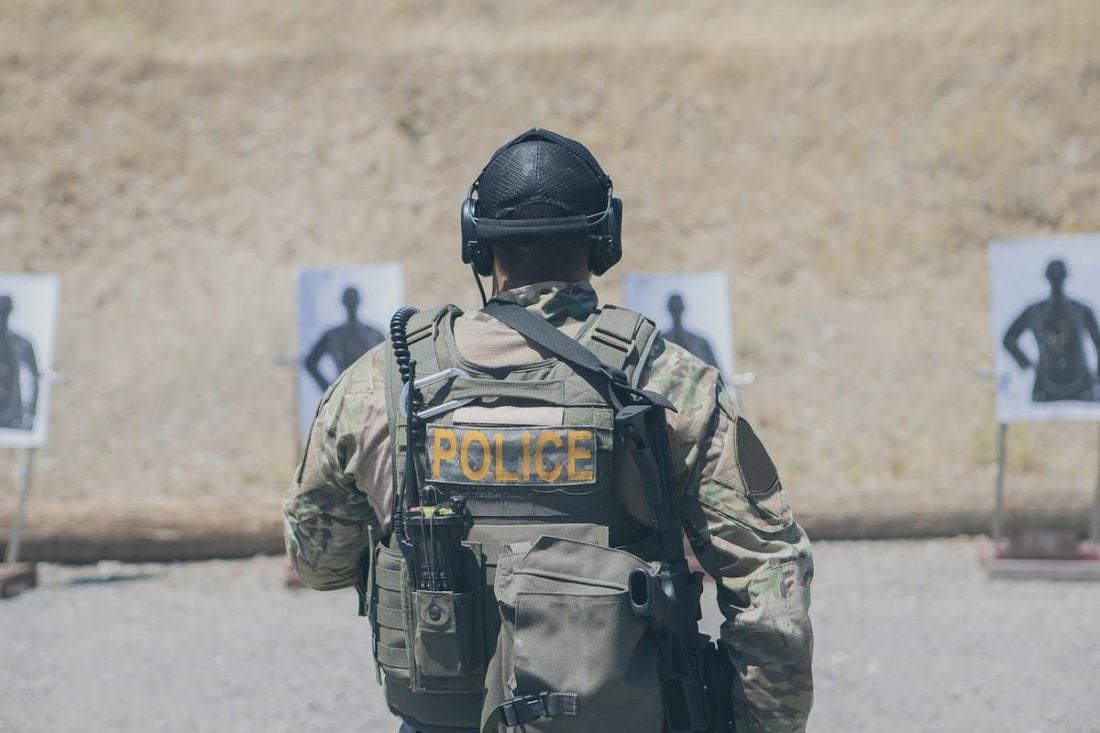
There are several design factors to consider when choosing hearing protection for shooting. It’s essential to take note of the features you care about to select a model that best suits your needs.
Cut-outs
Certain hearing protection devices come with cut-outs. These are indents or incisions in the ear cups that help contour the shape of safety glasses or the gunstock to the side of your head.
The notches on the earmuffs make it so that it won’t feel awkward to lean on the gunstock while shooting because the gunstock fits into the cut-out.
Tactile controls
Aside from glasses and HPDs, shooters also need other Personal Protective Equipment (PPE) like shooting gloves.
Shooting gloves are usually thick, so it’d be challenging to find and access regular headphone buttons without taking off your gloves when wearing these.
That’s why reliable tactile controls are essential. This helps you precisely know what you’re pressing, where it’s located on the HPD, and how many times you’re pressing it, even with gloves.
Durability
Hearing Protection Devices are constantly exposed to harsh environments and extreme conditions. That’s why it’s important to look for HPDs that can take a beating.
If you often find yourself hunting in rough weather, it helps to get a hearing protection device that is specifically advertised as sweat/water-resistant. Its durability also depends on the kind of materials that were used.
It’s good to look out for Acrylonitrile Butadiene Styrene and other synthetic materials for HPDs. Synthetic materials have been designed and optimized to offer the best protection possible. This means they can perform better than natural materials regarding both protection and longevity.
As sleek as they look, some HPDs should possess long-lasting properties in their exterior design that can protect them from UV degradation. Some of these properties include anti-scratch characteristics in their paint/designs.
Comfort and fit
Overall, the comfort and fit of an HPD are two of the more crucial yet underrated factors you should consider when choosing hearing protection. Whether in the shooting range or out hunting in the wild, chances are you’ll be wearing the devices for extended periods.
For earmuffs
For earmuffs, they must fit snugly and comfortably on your head. This is to minimize the incentive of taking them off. By doing so, you won’t be exposing yourself to potentially dangerous sounds.
Comfortable shooting earmuffs usually have large, soft ear cups that fully cover the ears. Having vented headbands also helps with additional airflow. You can also go for padded headbands known to provide more support to the head.
Lastly, adjustable/rotating sliders can better conform to different head shapes/sizes. The more the earmuffs can adjust to the size and shape of your head, the more comfortable it will be.
For earplugs
Earplugs must fit snugly into your ear for the most protection. If the earplugs are too large for your ear canal, this can result in immense discomfort.
On the other hand, if the earplugs are too loose, they will constantly fall out of your ears, exposing you to the dangerous sound levels you’re trying to avoid.
10 Best Hearing Protection for Shooting in 2023
Peltor Sport Tactical 500
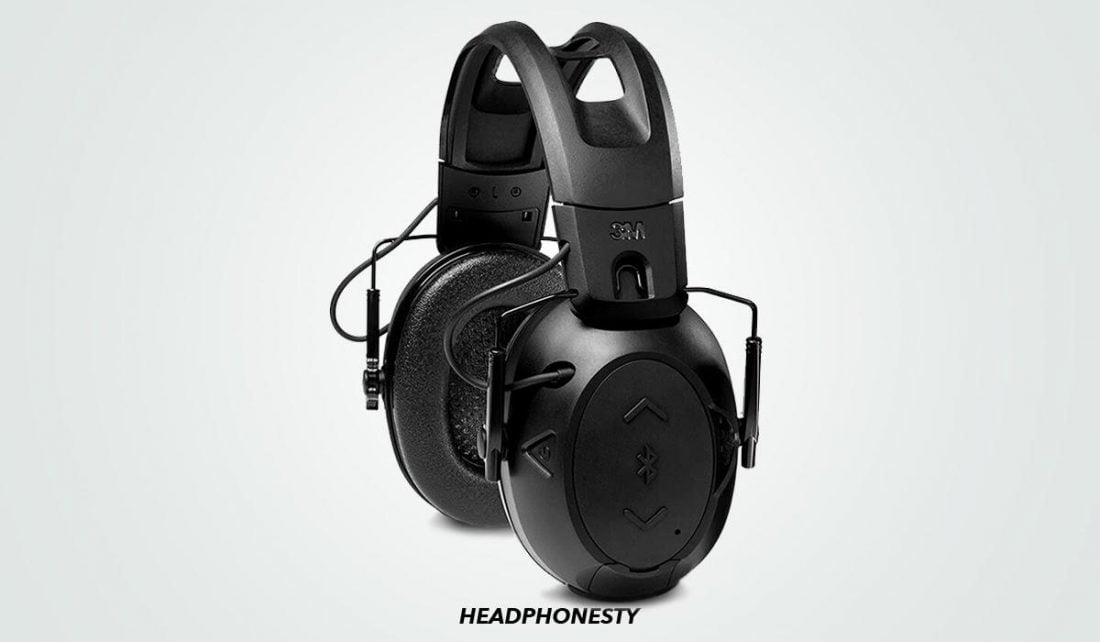
Key features for shooting
- NRR: 26 dB
- Derated NRR (OSHA): 9.5 dB
- Sound Amplification: Yes
- Directional Sound: Yes
- Attack Time: 3-5 ms
- Volume Limit: 85 dB
- Weight: 0.93 lbs
As made by the manufacturers of the renowned 3M Worktunes, it’s not that surprising to see the Peltor Sport Tactical 500s as the best overall pick for this list.
They have one of the highest NRR ratings and attack times among other HPDs on this list, in addition to other features that can be very useful during shooting sessions.
One of these features is the Automatic Dynamic Suppression, which is a proprietary 3M SMART technology. This technology measures gunshot energy and the corresponding surrounding echoes. It then adjusts the suppression time accordingly. This allows for optimized comfort and communication, especially for indoor shooting.
They also have precise voice tracking that specifically amplifies voices for improved communications. This helps you hear your teammates’ voices or commands above everything else.
Moreover, their lightweight form factor, low-profile design, soft ear cup cushions, and adjustable headband improves overall comfort for long hours of usage without ear fatigue.
However, their Bluetooth connection isn’t the most stable and can be prone to lags or disconnections– so they’re not recommended for music listening on long hunts.
Howard Leight Impact Sport Bolt
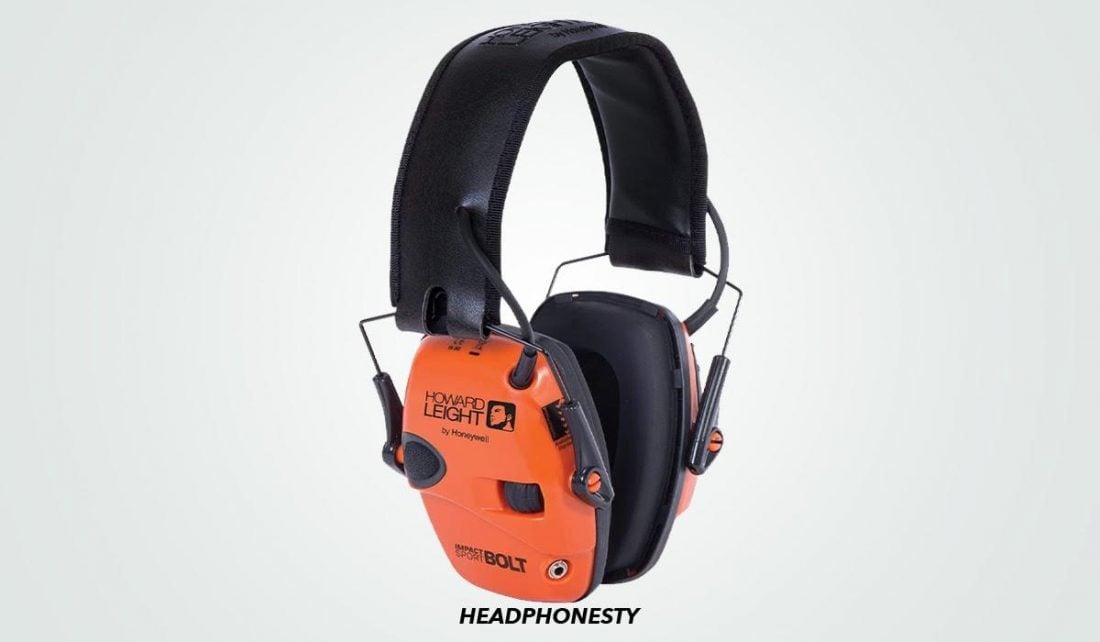
Key features for shooting
- NRR: 22 dB
- Derated NRR (OSHA): 7.5 dB
- Sound Amplification: Yes
- Directional Sound: Yes
- Attack Time: 0.5 ms
- Volume Limit: 82 dB
- Weight: 0.66 lbs
The Howard Leight Impact Sport Bolts are a strong-runner up for many reasons. This is thanks to their attack time of 0.5 ms, the fastest on this list. They have a good NRR and directional sound amplification that will block the dangerous sound levels while letting you experience the rest of the outside noise.
The Howard Leight Impact Sport Bolts also promise up to 5x directional sound amplification– 100% more than the average 4x amplification. This is useful while hunting as it allows you to pick up on the sounds of prey in your environment.
Furthermore, the low-profile ear cups, slim design, and rifle cutaways allow for better shooting accuracy and gun-to-cheek placement. The cut-outs can help you use a tight gunstock cheek weld for a better intuitive sighted/unsighted fire without disrupting the protective seal of the ear cushion.
However, be careful when turning the volume all the way up with these on. We found that these earmuffs can be prone to creating annoying high-pitched feedback noises.
Act Fire Shooting Earmuffs
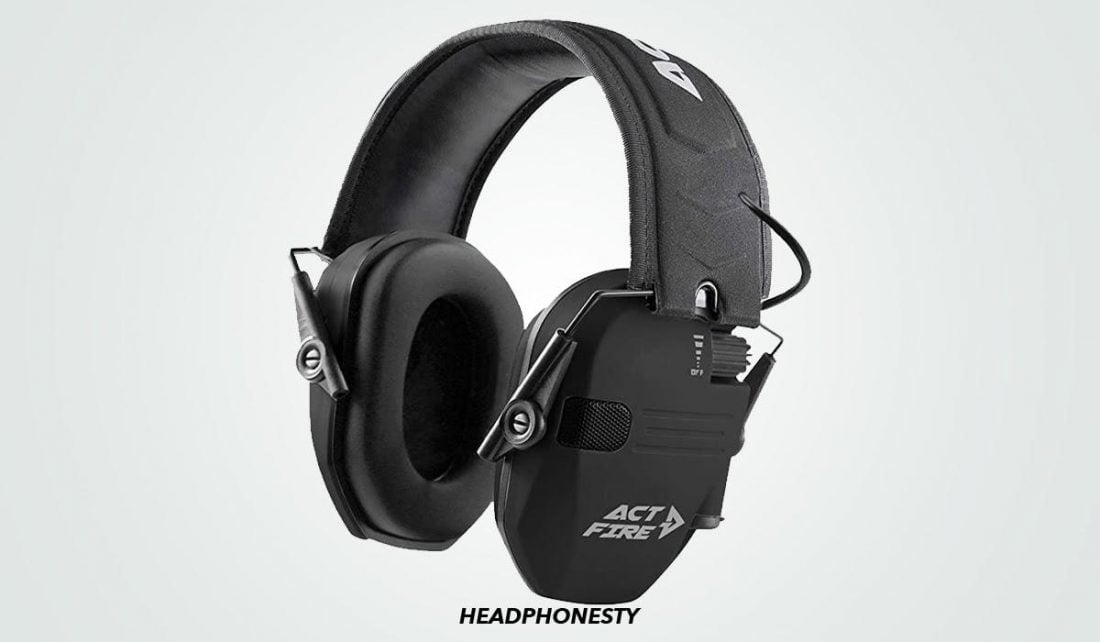
Key features for shooting
- NRR: 23 dB
- Derated NRR (OSHA): 8 dB
- Sound Amplification: Yes
- Directional Sound: Yes
- Attack Time: 20 ms
- Volume Limit: 89 dB
- Weight: 0.75 lbs
If you’re looking for a suitable shooting HPD without breaking the bank, then the Act Fire Shooting Earmuffs may be your best bet. These earplugs have the basic features necessary to serve as effective hearing protection in a wide variety of settings, with a 23 dB NRR.
Although other tactical noise-canceling HPDs also let you hear quiet sounds while protecting your hearing, this device stands out by amplifying those soft sounds with little to no sound distortion.
This is done by their unique internal chip for sound amplification, thus promising realistic and clear amplified stereo sound. Plus, not only do the internal amplifiers increase the volume of low-level sounds, but they also accurately determine the direction it is coming from.
They also sport one of the most aesthetically pleasing designs on this list– one that almost every American tactical shooting enthusiast would enjoy. For example, the incorporation of the American flag is an exciting addition to the overall design.
Plus, this HPD uses imported Japanese paint that helps protect the device better against UV irradiation, natural fading, and surface damage.
OTTO Engineering NoizeBarrier Micro
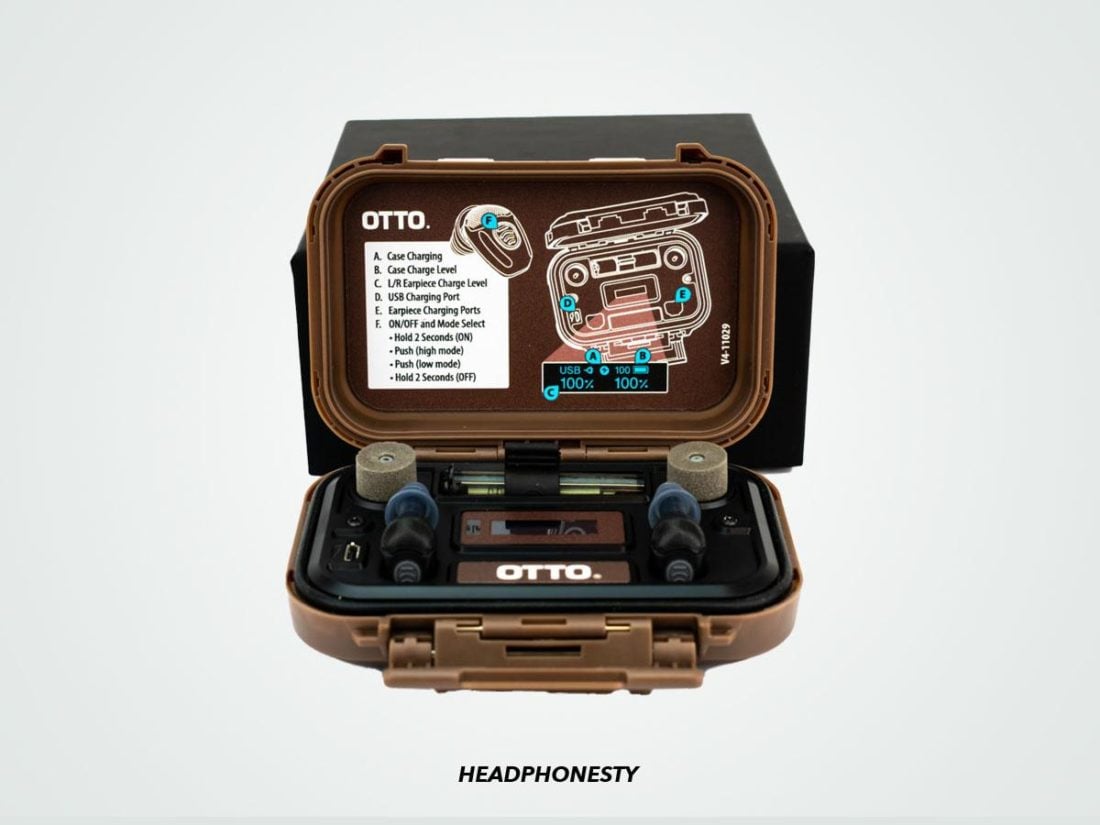
Key features for shooting
- NRR: 40 dB
- Derated NRR (OSHA): 15 dB
- Sound Amplification: Yes
- Directional Sound: No
- Attack Time: 20 ms
- Volume Limit: 85 dB
- Weight: 0.1 lbs
OTTO Engineering’s NoizeBarrier Micro electronic earplugs are a perfect pick if you’re looking for an exceptional HPD and are willing to spend a little more to get it. While these earplugs function as a high-quality HPD, they come with several extra quality-of-life features you’ll find handy while shooting.
Although the OTTO NoizeBarrier Micros have an incredibly high NRR rating, the noise reduction remains smooth and seamless. This means you can continue a conversation while the guns are firing.
The sound amplification is also designed with 360-degree detection and localization – a feature that isn’t quite prevalent for earplugs. They can amplify sound up to 5x your natural hearing while being equipped with two modes to choose from: sound amplification and sound dampening.
They come with a sturdy case, which isn’t just robust enough to protect your earplugs from damage but also charges them when they’re slotted into place!
The case even has a display to show you how much charge the earplugs have and how much power is left in the charging case itself. However, the earplugs themselves have a 16-hour battery life, so you shouldn’t need to use it often!
The earplugs also come with a cleaning kit to keep your ears free from infection. Plus, to help the earplugs to conform to your ears, they come with three ear tips of different sizes.
Also, even though they’re loaded with high-quality features, these earplugs are discreet and don’t protrude when worn. You wouldn’t have to worry about them interfering with other safety equipment.
Walker’s Silencer BT 2.0
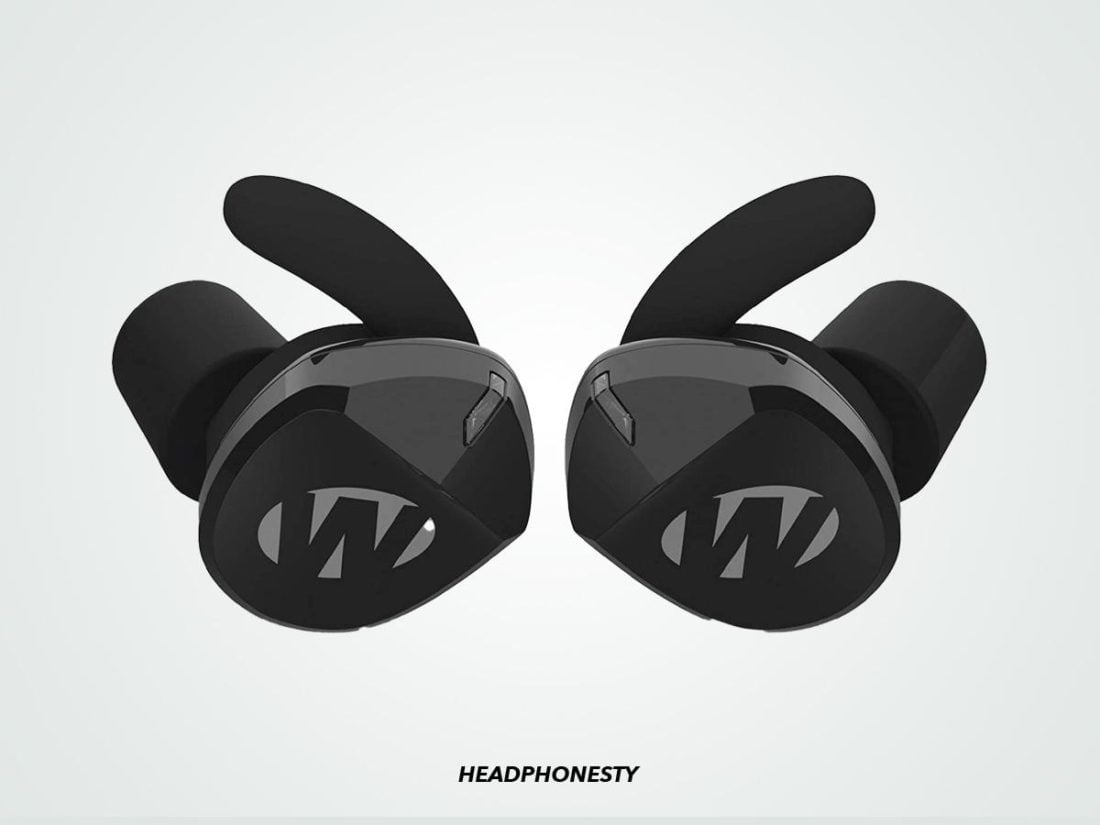
Key features for shooting
- NRR: 24 dB
- Derated NRR (OSHA): 8.5 dB
- Sound Amplification: Yes
- Directional Sound: No
- Attack Time: 20 ms
- Volume Limit: 85 dB
- Weight: 0.1 lbs
The Walker’s Silencer BT 2.0 electronic earplugs are another excellent option for in-ear protection. Though their NRR is not as high as the abovementioned high-tech earplugs on this list, the Walkers come with many other stand-out features.
One of these is the mobile controls. These earplugs come with a downloadable app that you can use to customize your earplugs’ controls, such as by adding voice controls to operate the Walkers Silencer BT 2.0 without touching them. As you can imagine, this would be a huge boon when shooting.
The Walkers Silencer BT 2.0s even have a Bluetooth connection that you can use to enjoy your favorite music while shooting wirelessly!
Additionally, these earplugs also come with dynamic wind noise reduction. If you’re out shooting in the wild or within a gun range with lots of ventilation, these are the earplugs for you.
Lastly, these earplugs also come with three sizes of Sure-Lock fins and foam ear tips to help you choose the right fit.
Also good: AXIL GS Extreme 2.0
With a derated NRR of 11 dB, the AXIL GS Extreme 2.0 electronic earplugs have a higher protection level than the Walkers Silencer BT 2.0.
However, they do lack some useful features that the Walker’s Silencer BT 2.0s have, such as the app controls. But with 25 hours of run time, these earplugs are a good alternative.
GLORYFIRE Electronic Shooting Earmuff
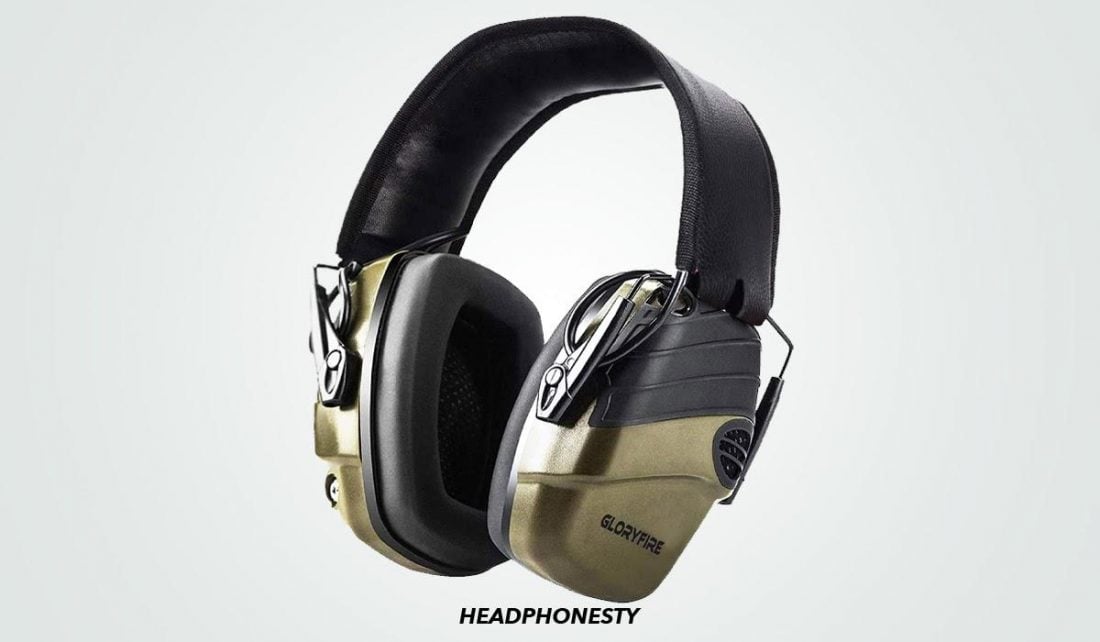
Key features for shooting
- NRR: 25 dB
- Derated NRR (OSHA): 9 dB
- Sound Amplification: Yes
- Directional Sound: Yes
- Attack Time: 20 ms
- Volume Limit: 82 dB
- Weight: 1 lb
The GLORYFIRE Electronic Shooting Earmuffs are our pick for the best HPD for hunting. That’s because they have the highest sound amplification (up to 6x) on this list. They also have some of the most accurate directional sound designs.
Hearing the sound cues you wouldn’t usually pick up on will give you the hunter’s edge and improve your overall hunting experience. You’ll be able to hear your prey approaching from further away and pinpoint their location while remaining undetected.
These earmuffs also have decent noise reduction. Although they don’t have the highest NRR on this list, they still provide solid hearing protection of 25 dB NRR.
Additionally, the Gloryfire Electronic Shooting Earmuffs also use a premium sound microchip. This helps maintain high-quality sound when listening to music or podcasts while you wait in hiding.
These earmuffs are designed to be comfortable, with a padded headband and soft earcups, which helps keep your ears safe as you don’t have to take off your HPD prematurely. This also makes the earmuffs suitable for all-day use, which is important on long hunting trips.
However, make sure you’re careful when using the earmuffs outside in inclement weather. This HPD is not waterproof.
PROHEAR 030
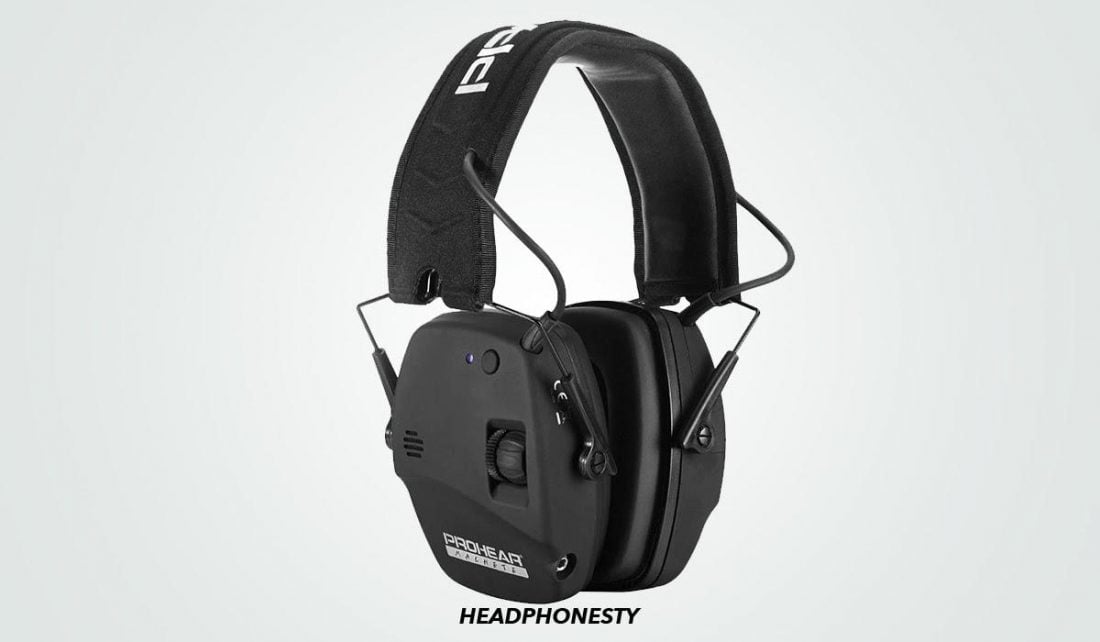
Key features for shooting
- NRR: 22 dB
- Derated NRR (OSHA): 7.5 dB
- Sound Amplification: Yes
- Directional Sound: No
- Attack Time: 10 ms
- Volume Limit: 82 dB
- Weight: 0.63 lbs
The PROHEAR 030s are the most versatile HPD on this list. This is mainly due to their Bluetooth capabilities and intuitive volume controls. These features combined make for an improved shooting experience, as well as offering other applications outside of shooting.
Apart from this, the NRR and sound amplification work well at the shooting range or out on a hunt.
Their integrated Bluetooth 5.0 technology allows you to keep a stable wireless connection with your media player device. This connection works up to a range of 33 ft. Connecting to other Bluetooth-enabled devices and seamlessly streaming music can drastically improve your overall shooting experience.
They feature wide ear cups, ultra-soft cushioned ear pads, and a thickly-padded headband. This allows you to wear the PROHEAR 030s for much longer without experiencing ear fatigue, which makes them especially useful during those extra-long shooting/hunting sessions.
Weighing in at only 0.63 lbs, this HPD is the most lightweight one on the list.
These earmuffs feature an adjustable ergonomic headband design, allowing them to fit different head shapes and sizes. Additionally, their compact folding design means you can bring these earmuffs wherever you go without worrying about transportation.
Walker’s Game Ear Razor Slim
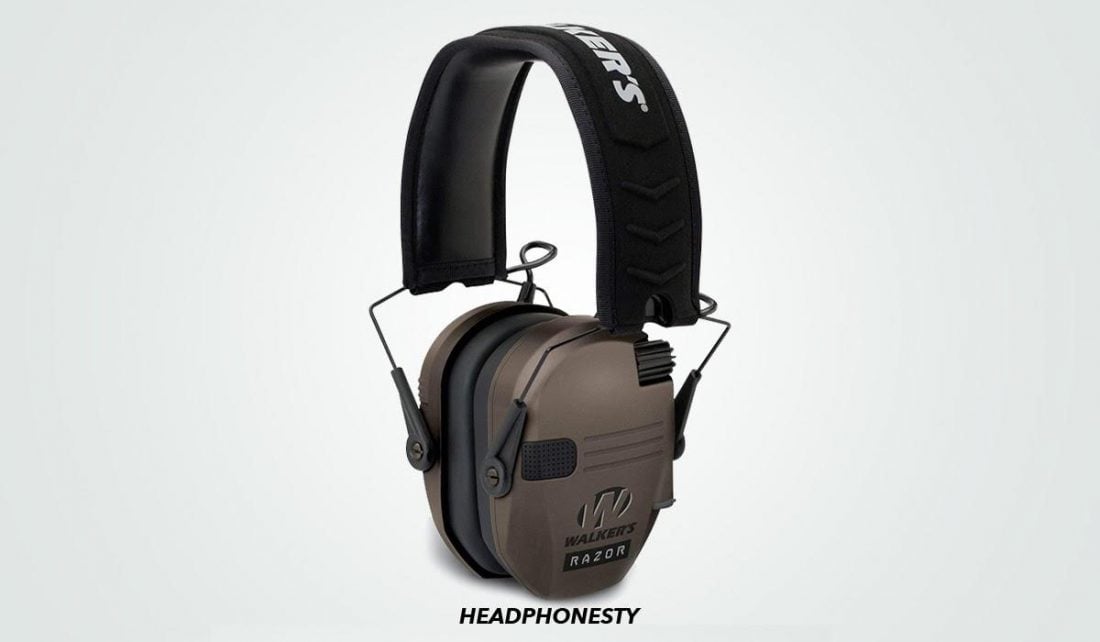
Key features for shooting
- NRR: 23 dB
- Derated NRR (OSHA): 8 dB
- Sound Amplification: Yes
- Directional Sound: No
- Attack Time: 20 ms
- Volume Limit: 89 dB
- Weight: 0.89 lbs
Comfort and a low-profile design are significant factors in shooting hearing protection. If that’s what you’re looking for, then the Walker’s Game Ear Razor Slim may just be what you need.
The Razor muffs are specifically engineered to have the lowest possible profile. They do this without compromising the muffs’ hearing protection and sound amplification properties, comfort, or functionality.
Despite this, the earcups and headband are also thickly padded and have ample clamping force to keep them comfortably in place all day.
Additionally, the device also features highly tactile and accessible volume control. The raised ridges on the volume knob allow you to adjust the sound levels accurately, even when wearing thick shooting gloves.
Of course, it’s also worth discussing the hearing protection it provides. The Razor Slims use a sound-activated compression circuit (SAC) to block out sounds that go over 89 dB in just 20ms.
Lastly, they come with 2 AAA batteries to get you started and are available in a variety of colors.
PROHEAR 016
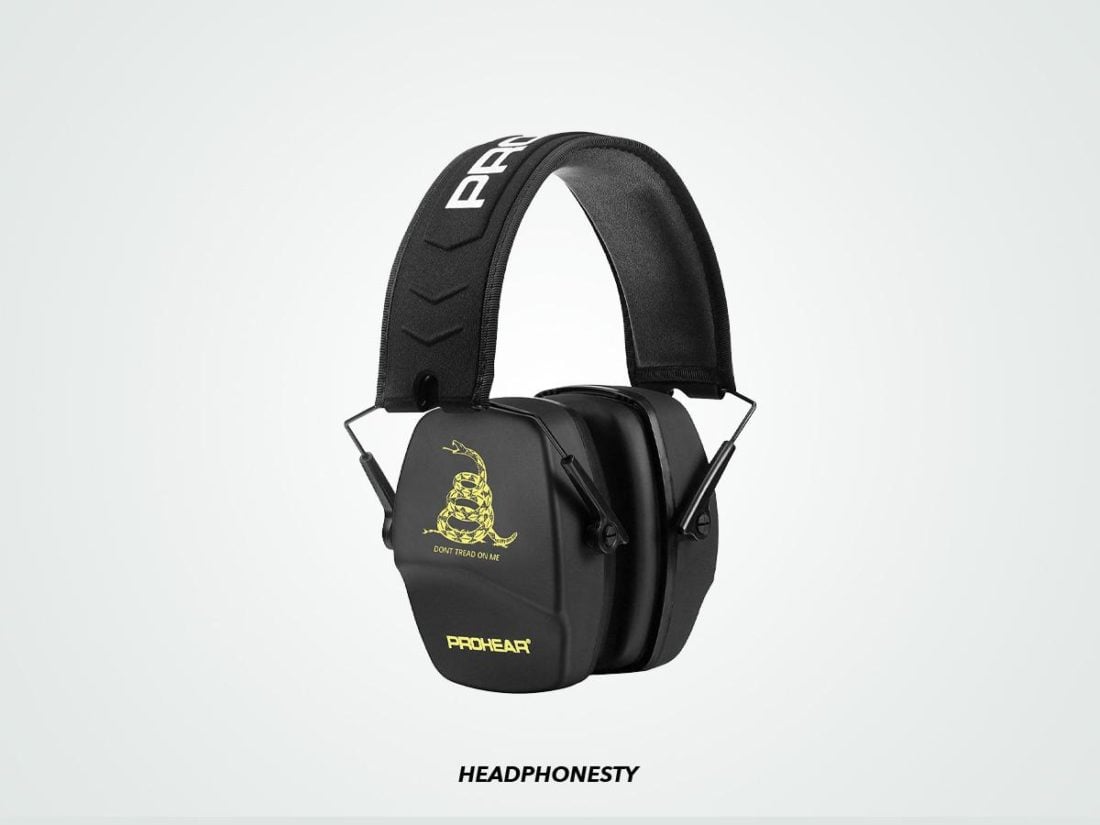
Key features for shooting
- NRR: 26 dB
- Derated NRR (OSHA): 9.5 dB
- Sound Amplification: No
- Directional Sound: No
- Attack Time: N/A
- Volume Limit: N/A
- Weight: 0.46 lbs
If you’ve decided that passive protection is what you need, then the PROHEAR 016 are a quality pair of passive protection earmuffs worth looking at. They offer a high NRR without the need for electronics, which makes them easy to use and store without considering charge.
Designed with both comfort and safety in mind, the 016s come with wide, cushioned ear cups and an adjustable, padded headband. They are also foldable, meaning that they can easily be carried around.
In addition, because they lack the electronic components found in others on this list, the PROHEAR 016s are very lightweight at only 0.46 lbs. That makes these earmuffs easy to wear for long periods without experiencing any discomfort.
The PROHEAR 016s are coated in high-quality rubber paint, so the design and exterior are predicted to last a long time. However, these HPDs are still made primarily of plastic. This makes them susceptible to damage after daily wear and tear, especially in harsh conditions such as hunting.
SureFire EP10 Sonic Defenders
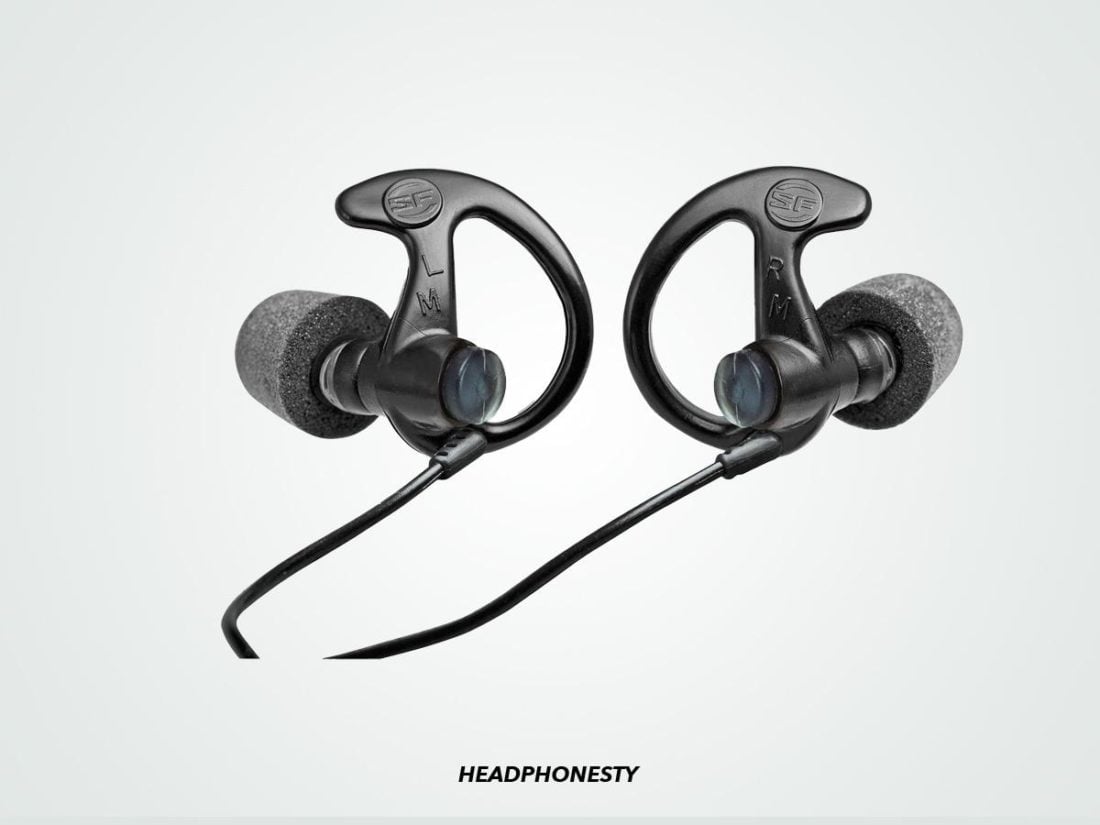
Key features for shooting
- NRR: 30 dB
- Derated NRR (OSHA): 11.5 dB
- Sound Amplification: No
- Directional Sound: No
- Attack Time: N/A
- Volume Limit: N/A
- Weight: 0.04 lbs
If you’re looking for a low-profile pair of passive protection earplugs, then the SureFire EP10 Sonic Defenders could be the ones for you.
As the lightest weight HPD on this list, the SureFire earplugs are guaranteed to offer you the ultimate comfort. This is enhanced by the memory foam ear tips, designed to conform to your ear canal for maximum protection.
Because the earplugs are so small and low-profile, you can use them in conjunction with any protective gear. This includes helmets and safety goggles, so you can be sturdily protected from any danger without risking your hearing.
The SureFires also come with a patented EarLock design. This keeps the earplugs locked into your ears with seven points of contact for maximum security possible for any pair of earplugs.
However, this design requires the user to wear the earplugs differently than standard ones since their wings have been created to stay within the Concha bowl. So wearing them is something you’ll have to get used to.
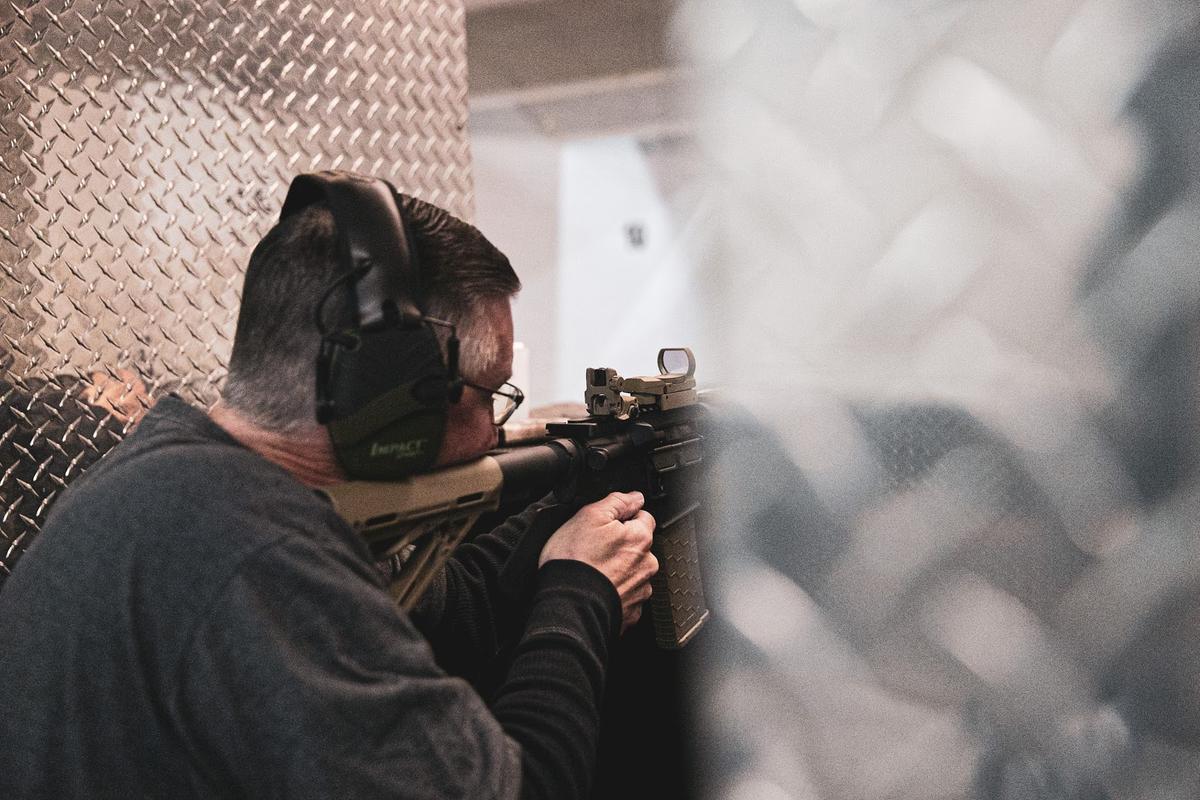
Hands down Axil is better than all of these. Come on if you are going to compare at least include the best.
I purchased from Axil. I never could get a decent seal; hence they were worthless.
I contacted Axil customer disservice…. they weren’t any help.
Mine just sit on a shelf, as an education to not believe salespeople.
NEVER accept unconditionally information provided from anyone selling the item. They’ll tell you whatever they think you want to hear. Why? To make the sale, obviously. What happens AFTER the sale is on YOU, and they have your money, which was the objective to begin with. Just don’t DO IT.
Axil states theirs are not directional. One mic picks up the sound. Directional situational awareness is MANDATORY. Under no condition will I consider any electronic noise cancelling device if using it costs me directional awareness.
I’d rather stick with ear muffs I put on for firing.
And, no mention anywhere here about the superlative hearing protection products available from Sordin – absolutely unexcusable. They’re superior to most anything out there, and you ignore them. Shame on you.